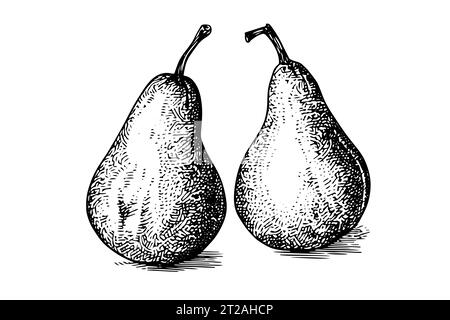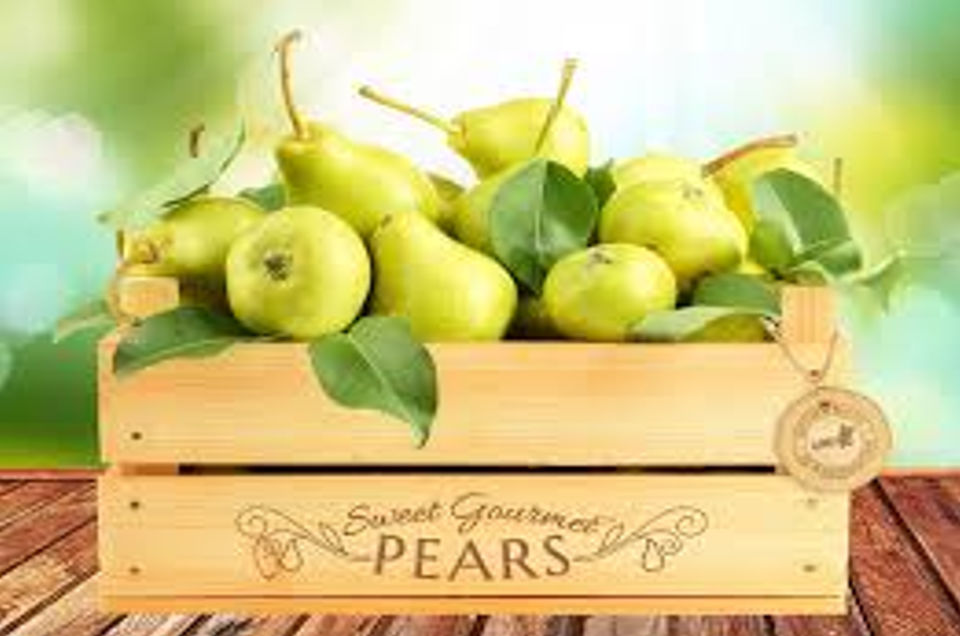Eating a pear at its peak, when it’s not rock hard but yet not too mushy, is like seizing not only the day, but the entire season. It’s one of those October sensations, like crunching through dry leaves, that feels even better because it’s ephemeral. A perfect pear personifies mellow fruitfulness, with its softly developing pyriform shape.
Consumer analysis suggests that the main reason for the pear’s recent sales decline (along with perceived inconvenience of its juiciness and shape) is “lack of flavour”. This seems odd. At its best, a pear is so deeply scented that it is like perfume disguised as fruit. Then again, as Edward Bunyard wrote in The Anatomy of Dessert in 1929, the pear “withholds its secrets from the merely hungry” because it needs to be picked unripe but eaten ripe. In a world of instant gratification, a pear is that rare food that refuses to be rushed.
OK, so you can cheat and buy a pack of “Perfectly Ripe Williams Pears” from M&S flown in from Spain or Italy, but even these will taste infinitely better if you give them half a day at room temperature to let the fragrance bloom.
Too many times, I have berated the pears in my fruit bowl for being dull when really the fault was mine for failing to wait for the fruit to reveal its magic. Even a nondescript Conference the most planted pear in Europe but far from the most fragrant or interesting can ripen into something meltingly sweet if you give it time. “I suppose . . . you have sometimes plucked a pear before it was ripe, Master Copperfield?” asks Uriah Heep in Charles Dickens’ David Copperfield, alluding to his premature announcement of his plan to marry Agnes. We probably all have.

Pears are a paradoxical fruit. Throughout history, they have had a reputation for exceeding apples in flavour and yet have seldom attained the same level of popular appeal (the exception being canned Bartlett pears, which, from their Californian heyday in the 1930s, have always sold in far greater volume than canned apples).
The Enlightenment naturalist Pierre Daubenton wrote that good pears were “infinitely superior to the finest apples”. But he also noted that pears were not as popular with “the common people” because apples could be eaten before they were ripe whereas “unripe pears are intolerably tart”. Today, unripe pears are not even tart, just bland and turnippy.
“There’s this snag with pears,” says pear expert Joan Morgan, “that you have to buy them unripe and ripen them at home, so there’s not the instant satisfaction of an apple.”
Prosaic world. Speaking from her home in Kent, Morgan tells me that she feels sad that pears are losing out to other fruits. “The number in cultivation has declined from 50 years ago,” she says.
The Defra National Fruit Collection at Brogdale in Kent lists more than 500 pear varieties, but it is a rare farmer who grows anything other than the Conference pears that supermarkets demand. And pears have competition now, not just from the apples but from fresh strawberries and raspberries, which are available year-round. Morgan wishes that more people knew the joy of pears because at their best, she writes, they are “gold to the apple’s silver”.
To enjoy a pear in season, ideally buy or pick it at least a few days before you want to eat it and keep it in a bowl “somewhere not too hot” says Morgan. Two of her favourites are Doyenné du Comice — whose luscious, barrel-shaped fruit she calls the “pear of superlatives” — and Beurré Hardy, which she sometimes finds from suppliers in Kent, and which tastes intensely of rose water.
Once you have your pear, watch and wait. Like a boiled egg, you can’t know for sure from the outside whether it is ready or not. But there are a few clues. When you touch the pear’s neck — the narrow part near the stalk — it should yield slightly and the skin may smell faintly of wet roses. When you bite into it, the white, deeply perfumed flesh is bursting with juice but should still offer some resistance. Above all, the texture is rich and buttery, even though it contains no fat.

This buttery texture is — along with their extraordinary shape — what sets a pear apart from its fellow tree-fruit, the apple. Admittedly, there are still some delicious pear varieties that are not buttery but firm and crisp in texture, such as the Passe Crassane winter pear grown in France, whose stalks are coated in red wax to protect them from moisture loss. There are also the apple-shaped Asian pears yet these are a whole other fruit, botanically speaking.
Buttery flesh is, though, a characteristic of most of the best dessert pears from Williams to Comice to Concorde to the lovely Bosc, which I always buy when I am in the US, and which I wish we could get here. The only fruit I can think of that exceeds a pear in butteriness is the Alphonso mango. So I was surprised to find that the buttery pear is a relatively recent historical invention. We owe its existence to a visionary 18th-century plant breeder who took the pear and spent more than 50 years working to improve it.\
Please use the sharing tools found via the share button at the top or side of articles. Copying articles to share with others is a breach of FT.comT&Cs and Copyright Policy. Email [email protected] to buy additional rights. Subscribers may share up to 10 or 20 articles per month using the gift article service. More information can be found here.
https://www.ft.com/content/b242f386-a4ae-4c7e-b368-ed3299e5b80e
Pears in general are a very ancient fruit. Traces of wild pears have been found in Neolithic sites in the Caucasus and across Europe. But these would have been nothing like a modern dessert pear. The French novelist Alexandre Dumas wrote that on account of their disappointing taste and puny size, wild pears were known as “poires d’angoisse” or pears of anguish.
The closest to a modern equivalent of a wild pear would be the perry pears that are still grown in England to make perry (like cider but made from pears). In his new book Eating to Extinction: The World’s Rarest Foods and Why We Need to Save Them, Dan Saladino goes on the hunt for rare varieties of perry pears in Herefordshire in the company of perry maker Tom Oliver (whose perries you can buy at thefinecider.company). Oliver is one of just a handful of British producers carrying on the old traditions of perry-making. He regards one of his trees — the Coppy, which carries yellow-red fruits — as a “living monument” because it is the only known one left in existence.
Oliver also grows other perry pears such as the Green Roller (which Saladino says looks like a miniature Conference pear), the Blakeney red (whose juice was used to dye uniforms khaki during the first world war) and “the Arlingham Squash, the shape of a teardrop”. When blended into one of Oliver’s perries, Saladino says, these perry pears make a drink that is “lighter than wine, more elegant than cider” with the “bittersweet taste of ripening orchard fruit”. But eaten raw, Saladino finds them overwhelmingly astringent, “as if all the moisture was being sucked out of your mouth”. And as the season goes on, Oliver tells me, perry pears become even harder and more astringent. In this, they are similar to older varieties of eating pear, which turned hard and sour as summer turned to autumn.

In medieval times, pears were mostly a fruit for cooking. The only domesticated pears that were sweet and juicy enough for eating fresh were the summer pears. The pears of autumn, by contrast, were tough, grainy and sour, like a quince. They needed long baking or stewing — and, ideally, plenty of honey and sweet wine — before they were remotely edible.
By the 17th century, buttery eating pears existed, but only on the richest tables. Jean-Baptiste de la Quintinie (1624-1688) was the horticulturist at the court of Louis XIV. An important part of his job was growing and selecting the pears for the royal table. Some were tiny and served in bunches like cherries and some were giant such as the Bon Chrétien d’Hiver, which sold for five shillings apiece during the 17th century (maybe £30 in today’s money).
Quintinie prided himself on doing such a good job of ripening the pears that none of the king’s guests should stoop to “Picking and Squeezing”. A good pear, in his view, could either be crunchy (“cassante”) with a pulp that “breaks short in your mouth” or it could have a “butter-like and smooth pulp” such as the Bergamote d’Automne. Quintinie considered these buttery ones the most valuable pears of all.
It is a kind of miracle that the buttery pears that were once the preserve of kings can now be freely bought as cheaply as apples. For this, we should thank Jean-Baptiste Van Mons (1765-1842), a Belgian plant breeder who devoted his life to the improvement of pears and whose many innovations included Bosc and d’Anjou. Over 51 years, he invested nearly 300,000 francs in his pear-breeding programmes. Van Mons’ revolution, as Joan Morgan explains to me, was to find a way to produce pears that had a good yield and hardiness but also “this juicy melting texture and perfume throughout the season”.


